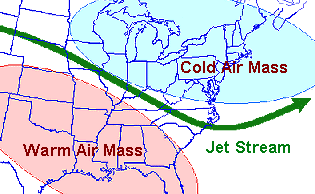 The JET STREAMS located
in the upper troposphere (9 - 14 km) are bands of high speed winds
(95-190 km/hr). The term was introduced in 1947 by Carl Gustaf Rossby.
Average speed is very high with a lower limit of about 120 Kms in winter
and 50 km per hours in summer. The two most important types of jet
streams are the Polar Jet Streams and the Subtropical Jet Streams. They
are found in both the Northern and Southern Hemispheres.
The JET STREAMS located
in the upper troposphere (9 - 14 km) are bands of high speed winds
(95-190 km/hr). The term was introduced in 1947 by Carl Gustaf Rossby.
Average speed is very high with a lower limit of about 120 Kms in winter
and 50 km per hours in summer. The two most important types of jet
streams are the Polar Jet Streams and the Subtropical Jet Streams. They
are found in both the Northern and Southern Hemispheres.
Formation of Jet Stream
Warm air masses in the south meet cool air
masses from the north and create temperature and air pressure
gradients. In wind speed, the pressure difference between a high and low
pressure zone can be very large, thereby creating high winds. Pressure
and temperature differences in the jet stream can be large as a global
warm front from the south and a cold front from the north meet.
Polar Jet Stream:
These jet streams are created when cold
air from the Polar Regions meets warmer air from the equator. This
temperature gradient as a result forms a pressure gradient that
increases wind speed. During the winter, these jet streams bring
winter storms and blizzards to the United States and in summer, they
become weaker and move towards high latitudes. They are found in both the Northern and Southern Hemispheres.
Sub-Tropical Jet Stream:
 These
jet streams are formed as warm air from the equator moves towards the
poles that form a steep temperature incline along a subtropical front
that like the polar jet streams produce strong winds. In Southeast Asia,
India, and Africa, these jet streams help bring about the region's
monsoon or rainy climate. As these jet streams warm the air above the
Tibetan highlands, a temperature and pressure gradient is formed as the
air from the ocean is cooler than that above the continental high
lands. This as a result forms on-shore winds that produces the monsoon.
These
jet streams are formed as warm air from the equator moves towards the
poles that form a steep temperature incline along a subtropical front
that like the polar jet streams produce strong winds. In Southeast Asia,
India, and Africa, these jet streams help bring about the region's
monsoon or rainy climate. As these jet streams warm the air above the
Tibetan highlands, a temperature and pressure gradient is formed as the
air from the ocean is cooler than that above the continental high
lands. This as a result forms on-shore winds that produces the monsoon.


Post a Comment
Post a Comment